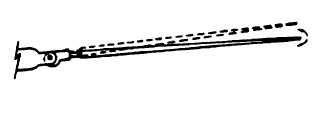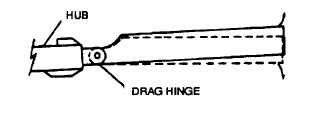TM 1-1500-204-23-5
because the relative wind changes from a horizontal
direction to a more upward direction. The combination of
decreased angle of attack on the advancing blade and
increased angle of attack on the retreating blade through
blade flapping action tends to equalize the lift over the
two halves of the rotor disk
(2) Blade feathering. The blades of a fully
articulated rotor can be rotated about their spanwise axis
or feathered. Feathering is accomplished by cyclic stick
movements which are transmitted by mechanical linkage
through the swashplate to change the pitch angle of each
rotor blade.
(3) Blade leading and lagging. The blade flap
ping action creates an unbalanced condition with resulting
vibration. To prevent this vibration, a drag hinge, as
shown in figure 3-8, is incorporated which permits the
blade to move back and forth in a horizontal plane. This
movement is called leading when the blade moves
forward and lagging when moving aft.
3-7. Main Rotor Blades Types, construction, and
classification of rotor blades, along with terms common to
them, will be discussed in the following paragraphs.
a. Types. There are two general types of main
rotor blades in use today. These types are metal and
fiberglass. They are described in the following
paragraphs.
(1) Metal. Aluminum is the most frequently
used metal in rotor blades due to its light weight and
strength characteristics. It is found in the honeycomb
core, spars, ribs, and doublers, and is also used as the
skin covering. Titanium is used for spars and abrasion
strips on some rotor blades.
(2) Fiberglass. Main rotor blades that contain
fiberglass may have straight fiberglass or may have a
composite mixture consisting of ingredients such as
fiberglass, titanium, Nomex, glass fiber epoxy resin, and
an elastomeric. Fiberglass is used for skin and spars.
NOTE
Metal and fiberglass rotor blades should
not
be
intermixed.
See
applicable
maintenance
manual
for
uses
and
restrictions.
b. Nomenclature. Table 3-1 contains terms and
definitions commonly associated with rotor blades.
c. Blade Construction. The various ways that main
rotor blades are constructed are described in the following
paragraphs.
(1) Single pocket fairing. A fairing consists of
formed and slotted ribs made of clad aluminum alloy to
which are bonded the upper and lower skins. The skins
are usually made of laminated, plastic-impregnated glass
cloth.
(2) Multiple pockets or fairings. These
fairings, also called basic fairing, contain formed and
slotted aluminum alloy ribs. The skins covering the
fairings are made of laminated scotchply. The fairings
are found between the root end fairing and the tip end
fairing.
(3) Internal structural components. Typical
internal structural components are the spar or spars, ribs,
doublers, wedges, and a honeycomb core.
Figure 3-7. Blade Rapping Action (Vertical Plane)
Figure 3-8. Blade Leading and LaggIng
(Horizontal Plane)
Change 2 3-7



